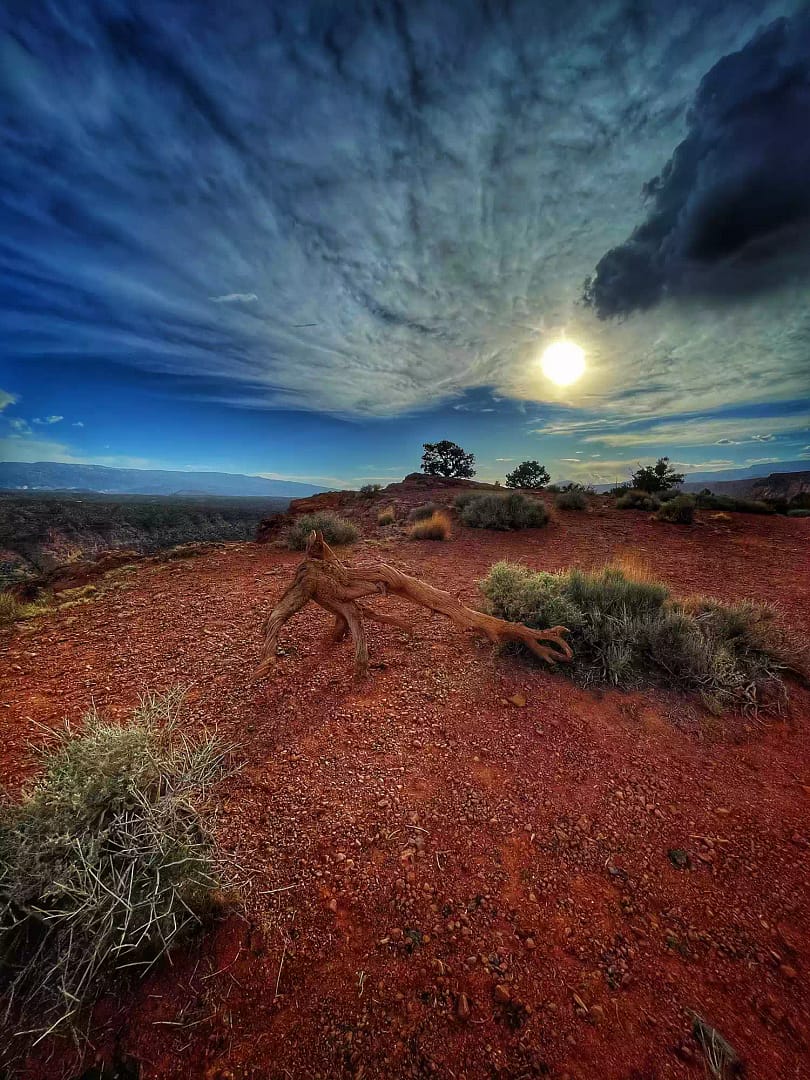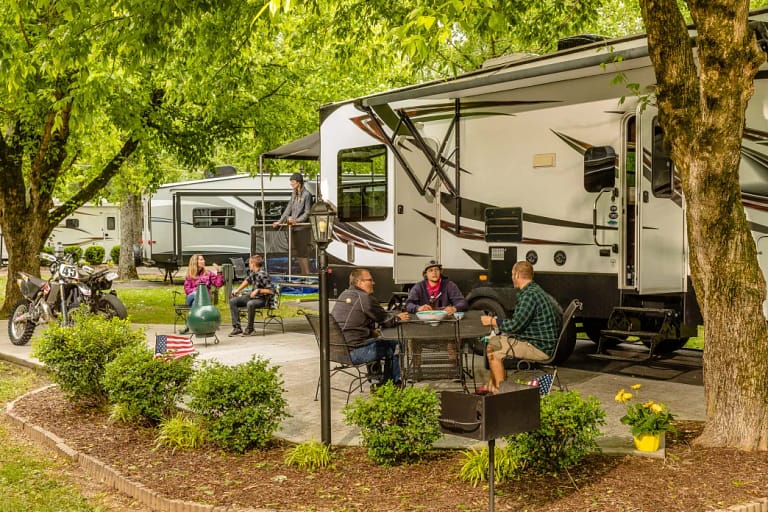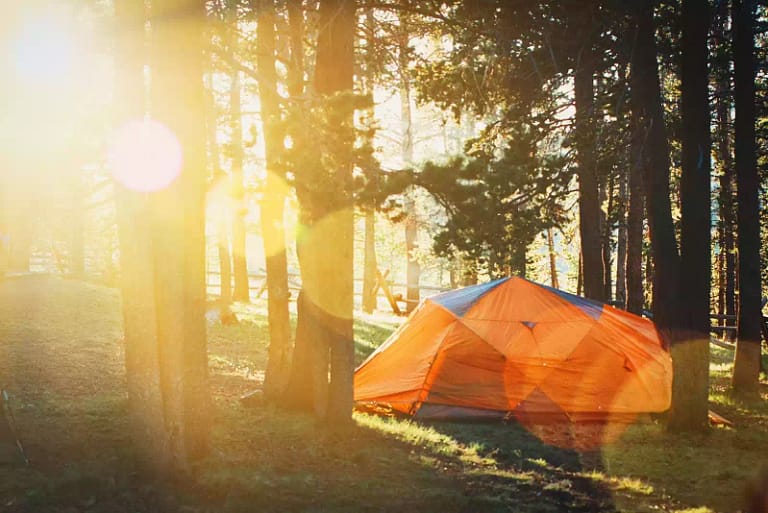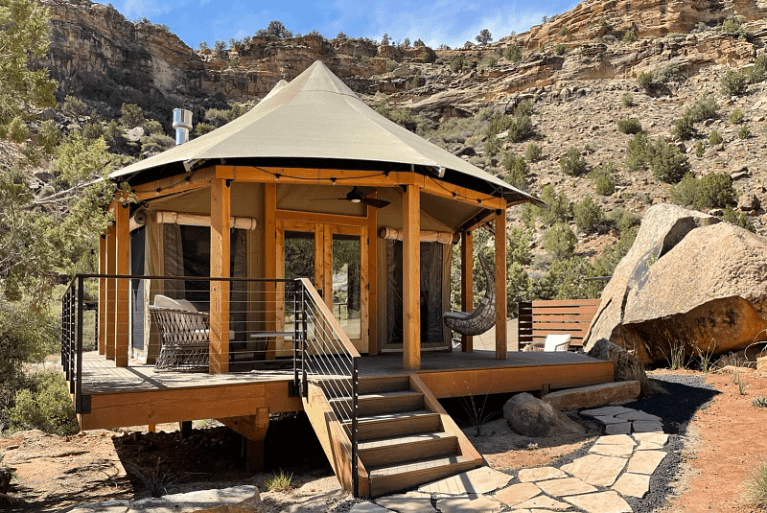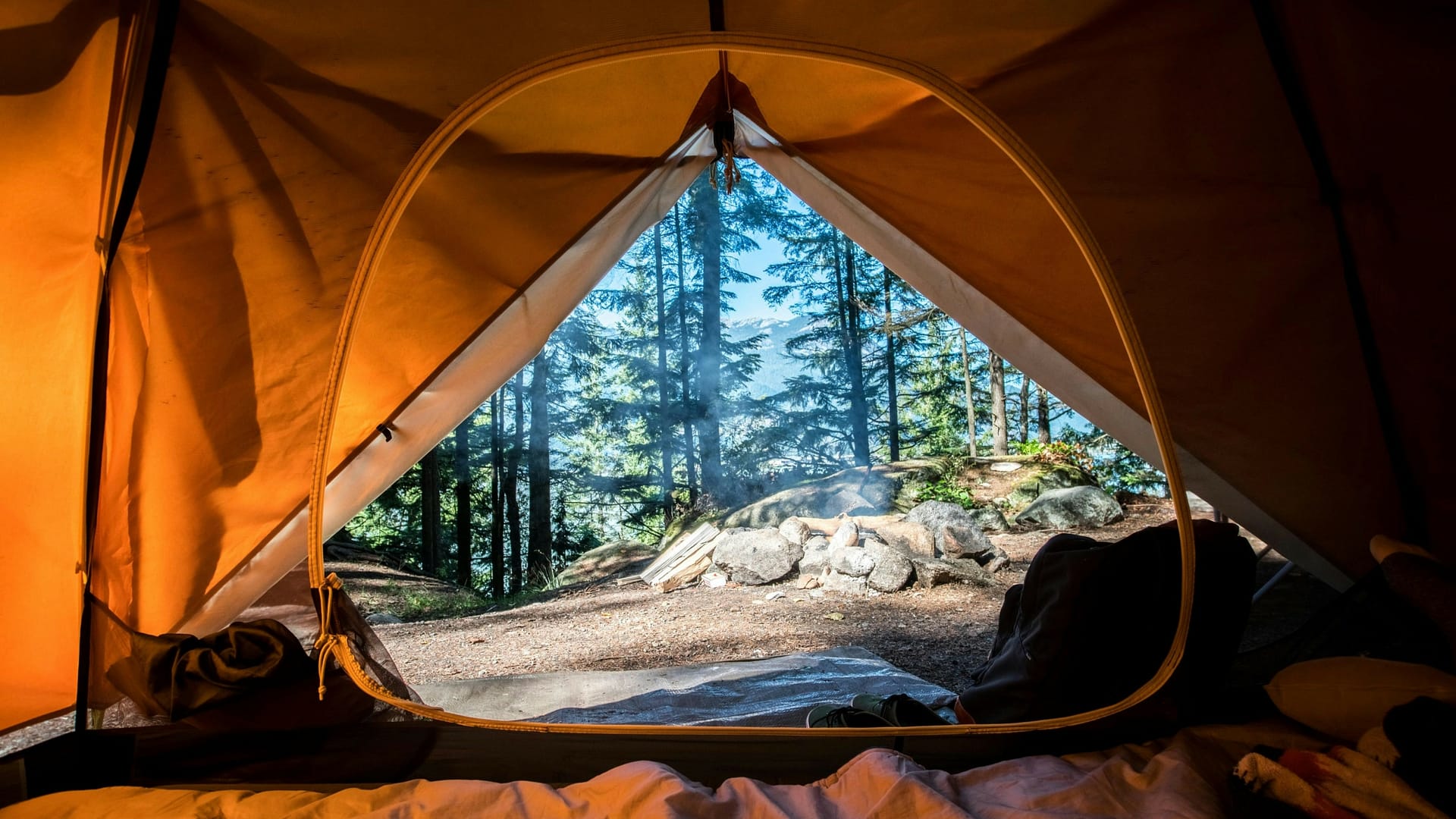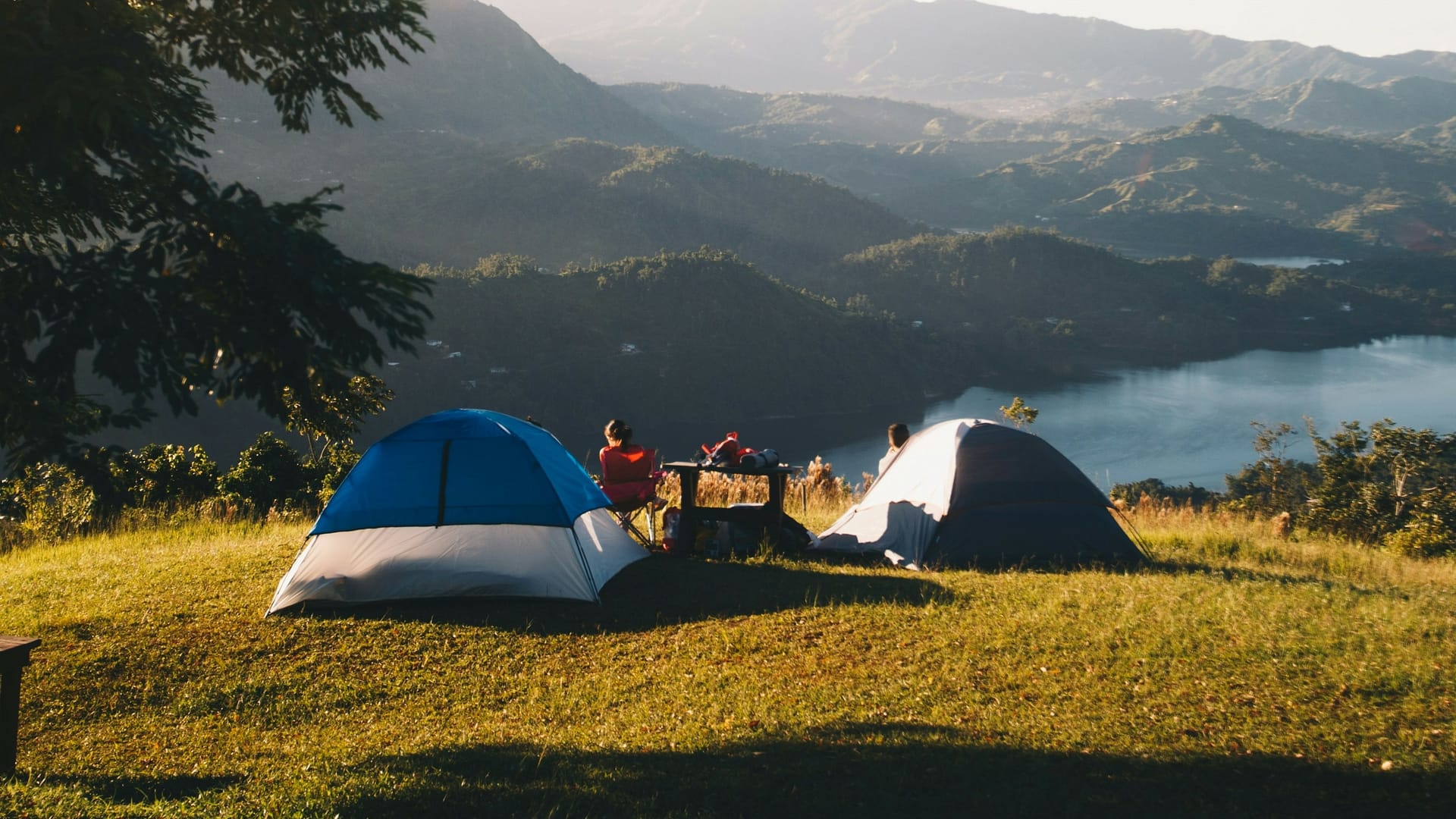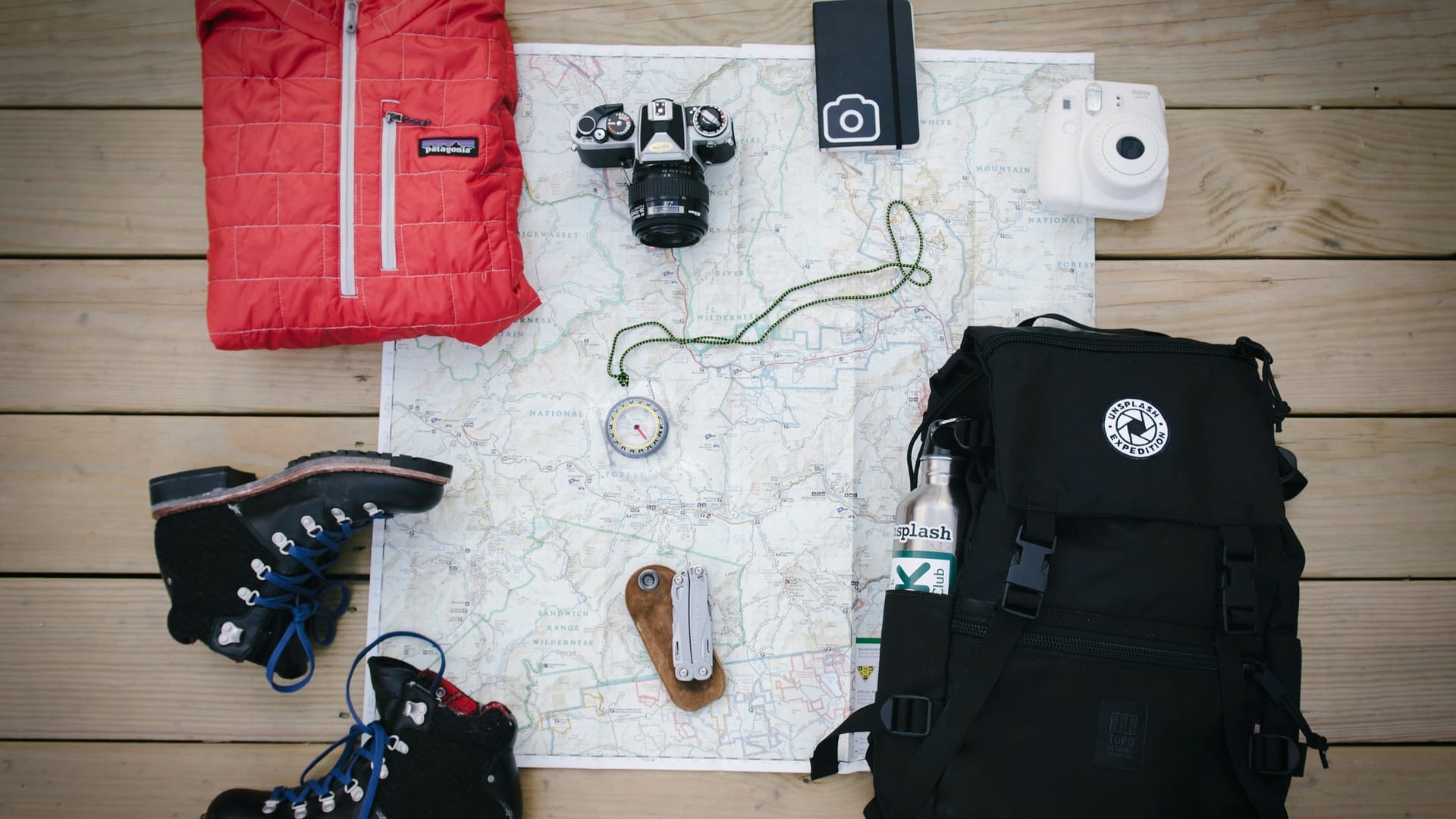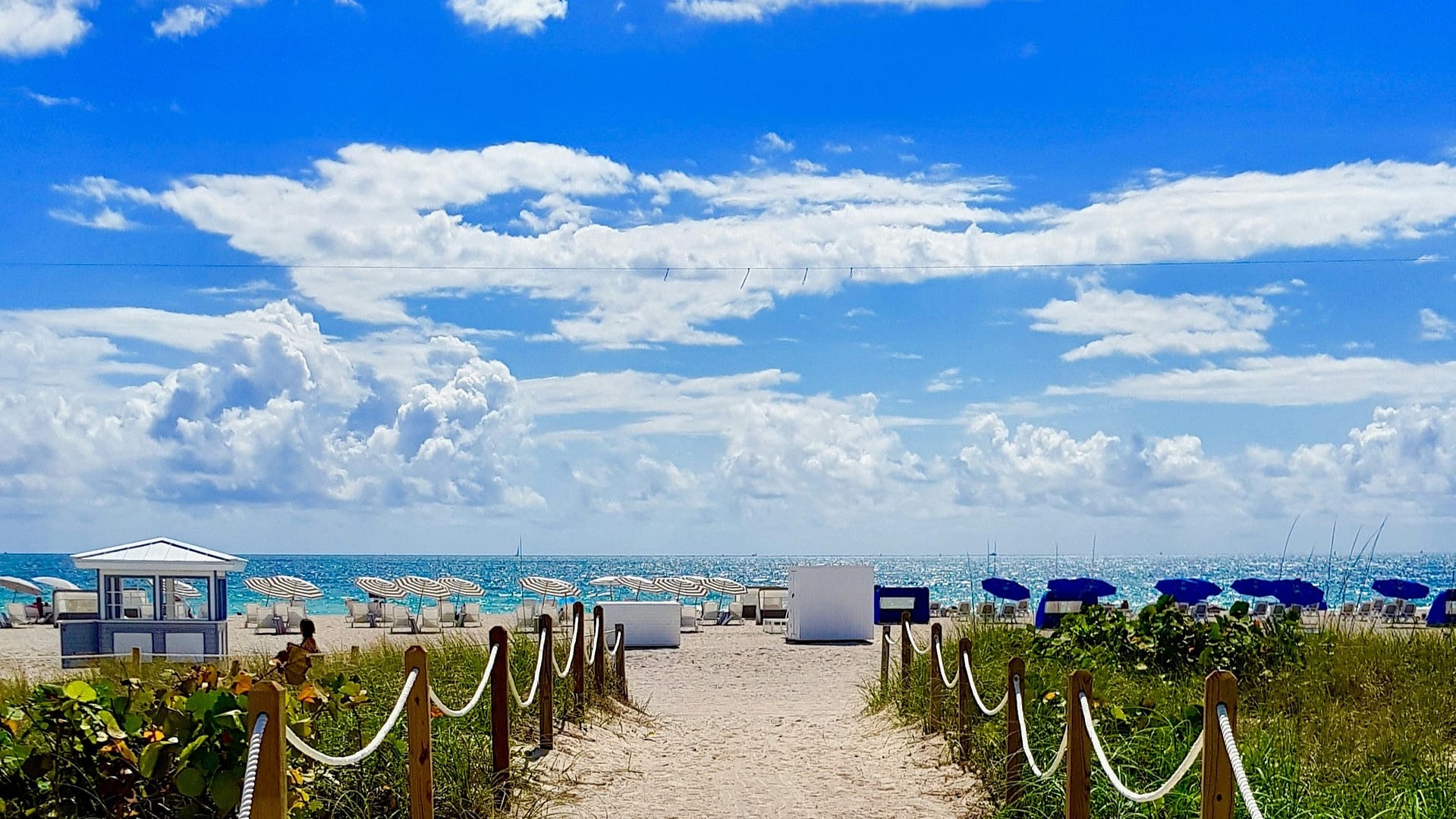Capitol Reef National Park in south-central Utah is a remarkable camping destination known for its unusual rock formations. Its geologic centerpiece is the Waterpocket Fold, a 65-million-year-old groove in the Earth’s crust where continental plates collided and slowly, slowly, slowly eroded. The result is exposed layers of colorful rocks and fossils, sandstone cliffs, canyons, buttes, and monoliths across the arid desert.
The national park is vast and remote enough for you to get that happy sense of human insignificance (no offense) that’s unique to camping. You know the feeling – you’re just a tiny speck on the tremendous landscape, under magical night skies, the likes of which are unknown to mere urbanites.
Yet, the park is readily accessible year-round, and there are places for camping near Capitol Reef to suit all desires. Campgrounds are fairly limited in number, though, so plan ahead and make sure you have reservations during the busy season of May through September. This is especially important if you’re particular about your campsites. You definitely want to reserve your spot early if you’re looking for Capitol Reef glamping spots, a tree-shaded tent site, or full hookup RV camping near Capitol Reef National Park.
In this article:
Toggle- Where To Camp Near Capitol Reef National Park
- Tent Camping Near Capitol Reef National Park
- Glamping Near Capitol Reef National Park
- Full Hookup RV Camping Capitol Reef National Park
- Things To Do While Camping at Capitol Reef National Park
- Ready To Go Camping at Capitol Reef National Park?
- FAQ Section
- Can you drive an RV through Capitol Reef National Park?
- Are dogs allowed in Capitol Reef National Park?
- What is the best time of year to visit Capitol Reef National Park?
Where To Camp Near Capitol Reef National Park
Campsites to suit every desire are available near Capitol Reef National Park, but they are fairly limited in number. During the high season, make reservations as far in advance of your trip as possible. Research the options and consider your most desired camping style, amenities, and location.
Camping Inside Capitol Reef National Park
Inside the boundaries of Capitol Reef National Park is one developed campground with 71 sites for tents and RVs, plus two primitive campgrounds in remote areas. The developed campground is reservable during the high season, and spaces fill up fast. It does not offer RV hookups, but it does have a dump station and water fill station. Backpackers may camp outside the established campgrounds in the backcountry with a free permit available at the visitor center.
All these options represent the more rustic side of camping, so look elsewhere if you prefer a few more luxuries.
Commercial Campgrounds Near Capitol Reef National Park
Commercial campgrounds near Capitol Reef offer the widest variety of sites and camping styles, and are the only way to enjoy glamping in the region. There are several commercial campgrounds with tent sites, full-hookup RV sites, and glamping options within just a few miles of the national park entrance.
The town of Torrey, 11 miles west of the visitor center, is the closest hub for camping, dining, shopping, and tour providers. If you want to camp within easy reach of urban conveniences (albeit limited ones; it’s a small town), choose a campground in Torrey. Other communities with campgrounds (but few other businesses) include Caineville, 19 miles east of Capitol Reef, and Hanksville, 37 miles east. Wayne County Travel Council lists four campgrounds around Torrey, plus another half a dozen in nearby communities. Some are open all year, and others close in winter.
Camping on Public Lands Around Capitol Reef
Camping near Capitol Reef for tents and RVs is available in the public lands – both Bureau of Land Management (BLM)-managed lands and Dixie/Fishlake National Forest – surrounding the national park.
The park service recommends four developed campgrounds in the national forest that are suitably located for visiting Capitol Reef. Three are in the Boulder Mountain area, and one is to the west of the park via Highway 24. Only some sites are reservable, and most (but not all) are closed in winter.
There’s also the option for dispersed camping in the Fremont River Ranger District of the national forest and within the BLM-managed Grand Staircase-Escalante National Monument. This type of camping is definitely “roughing it” and calls for a degree of self-sufficiency. Whether that’s a good thing or something to be avoided varies from person to person, and you know which camp you’re in.
Tent Camping Near Capitol Reef National Park
None of the commercial campgrounds near Capitol Reef National Park are for tents only. They all offer both tent and RV spots, and some have cabins. If you prefer a super-peaceful, vehicle-free environment, opt for dispersed camping on public lands. Of course, this means sacrificing amenities.
Consider the size of the campgrounds near Capitol Reef, as they vary from fewer than 10 campsites to more than 60. You might prefer a small, family-run site with little more than clean bathrooms, picnic tables, and fire rings, or a bigger, resort-like property with a pool, on-site cafe, and laundromat. Both styles are available, but you might have to compromise on some specifics.
What To Bring
A typical tent campsite near Capitol Reef is a hard rock, gravel, or concrete pad, often with a fence for blocking the wind. Upgrade to a thick or inflatable sleeping pad if you don’t already have one.
Few sites have shade, so bring your own canopy and ample sun protection if you’re camping during summer.
The most rustic campgrounds near Capitol Reef might not have drinking water available, so check in advance and bring ample supplies if needed.
Check fire restrictions in the Capitol Reef region, as well as individual campground policies, before setting up a campfire. Bring a propane stove for cooking.
Winters around Capitol Reef are very cold. If you’re considering tent camping around Capitol Reef in winter, make sure you have sufficient winter camping equipment and clothing. Be prepared for below-freezing temperatures and the possibility of snow.
Camping during the summer monsoon season requires serious precautions, too. Choose a campground with indoor spaces where you can shelter from storms, and especially from lightning, when needed. A laundromat can be a great amenity if you end up tent camping in the rain. Waterproof storage bags are a good idea, as well.
Glamping Near Capitol Reef National Park
Capitol Reef hasn’t quite caught up with the more stylish side of the glamping trend (yet!). Don’t expect any hipster-run solar-powered resorts, yurts furnished with interesting textiles, or gourmet coffee service. Instead, glamping near Capitol Reef National Park means renting a cabin at one of the local campgrounds that offer them.
Cabin rentals for Capitol Reef glamping vary in size and amenities, but share a rustic style. They generally sleep from two to six. Some are furnished with beds and little else beyond the relative luxury of four walls, a roof, and a private patio. Most, but not all, have heating and a/c. The fanciest cabins feature full kitchens, cable TV, private bathrooms, and stylish decor. Most cabin rentals are somewhere in the middle of this range.
What To Bring
Some cabin rentals at campgrounds near Capitol Reef come with linens and towels, and some offer linens for an extra fee. Bring your own linens and towels if needed, or err on the side of caution and pack these items just in case. Bring plenty of warm blankets if you’re staying in an unheated cabin during winter.
If your cabin has a kitchen, or perhaps just a mini-fridge and microwave, you might opt to bring groceries and prepare your own meals and snacks. Otherwise, you’ll still have enough space to store a packed cooler and considerably more luggage than you could bring for tent camping.
To make the most of the off-the-grid glamping vibe – even if you’re still very much on the grid – bring books, board games, and s’mores supplies.
Full Hookup RV Camping Capitol Reef National Park
As with all specific camping demands, RV sites with full hookups are available near Capitol Reef, but limited in number. None of the national park or public lands campgrounds have full hookups, so limit your search to commercial campgrounds. Book early if full hookups are a must for your RV trip. You should also book early if you have a big-rig RV or a strong preference for a pull-through site, as these types of spaces are limited.
Standard amenities available with RV camping near Capitol Reef National Park include full or partial hookups, a bathroom and shower block, picnic tables, and fire rings. Some upgraded amenities at larger RV campgrounds are laundromats, on-site restaurants, and camp stores. One of the biggest campgrounds has a pool, playground, basketball court, and on-site Jeep rental office, but this is not typical.
What To Bring
A packing list for RV camping near Capitol Reef National Park will vary by the type of RV you have, the campsite you’ve chosen, and the season. Winter campers might need chains or snow tires and should always have emergency kits in their RVs. Extra blankets are also a good idea during winter. Summertime visitors might bring extra fans or add a generator for a/c backup.
Things To Do While Camping at Capitol Reef National Park
All the adventurous outdoor activities we associate with camping, like hiking, photography, and biking, are popular ways to have fun in Capitol Reef National Park. Scenic drives are also a great way to take in a wider expanse of the landscape than is possible on foot. There are also some more unique activities available, including harvesting fruit from historic orchards and canyoneering.
Hiking
The most popular trails for day hikes in Capitol Reef National Park are in the Fruita area. This area features 15 easily accessible trails ranging from less than a mile to 10 miles round-trip. Some highlights include the sunset panorama at Sunset Point (obviously), the natural arch and canyon views at Cassidy Arch, and a 360-degree mountaintop vista as a reward for tackling the tough Navajo Knobs trail.
More than half of the Fruita area trails are steep and strenuous, and the park’s 5,500-foot elevation can make even the easier routes more difficult than you might expect. So, don’t be embarrassed if you’re huffing and puffing on a hike that’s supposed to be moderate – just blame the elevation!
More experienced hikers might pursue backpacking in the remote backcountry of the Waterpocket District or Cathedral Valley, where slot canyons, narrow gorges, and the occasional swimmable creek await. Consult a ranger at the visitor center to find a hike that matches your experience level.
Biking
Bicycles are allowed in Capitol Reef National Park, but they are considered vehicles and can only be used on designated roads. You may not bike on trails or any off-road areas. Bike touring means sharing the road with vehicles, so keep safety in mind. The park service recommends several bike tour routes ranging up to 124 strenuous miles, but shorter, easier rides are available too. Bring plenty of water, as none is available along the bike routes.
Photography
If you’re focusing on photography during a visit to Capitol Reef National Park, try to arrive early in the morning or stick around until the late afternoon for the best lighting conditions. The evening sun on west- and south-facing cliffs is especially stunning. You can definitely find photo-worthy vistas in any part of the park, including along the Scenic Drive and all hiking trails. Sunset Point and Gooseneck Overlook are must-snap spots. As an International Dark Sky Park, Capitol Reef is an amazing place to practice nighttime photography.
Horseback Riding
The region around Capitol Reef doesn’t just look like it belongs in an old western movie, it’s the genuine location roamed on horseback by Butch Cassidy and other Wild West outlaws. Evoke this feeling while remaining your law-abiding self with a horseback riding adventure in or around the national park.
Horseback riding inside Capitol Reef National Park requires a Backcountry Use Permit, available at the visitor center. Pleasant Creek is a popular spot for equestrian activity. You might want to arrange guided horseback excursions through one of several local tour providers.
Rock Climbing and Canyoneering
Capitol Reef National Park isn’t one of Utah’s more popular climbing destinations, but it does have a handful of locations suitable for climbing and bouldering. None are ideal for beginners, so make sure you have adequate experience and training before pursuing this activity. Permits are required.
Canyoneering is a superb way for adventurous campers to spend some time in the national park. It typically involves rappelling, technical rope work, scrambling through claustrophobic slot canyons, and sometimes swimming, so it’s definitely not an activity suitable for all. Free permits are required, and you must know the rules and regulations for canyoneering, rock climbing, and scrambling in the park.
Ready To Go Camping at Capitol Reef National Park?
Capitol Reef offers immense rewards and lifelong memories for campers, so it’s an excellent idea to plan a camping trip to the national park. The scenery is spectacular, the weather is mostly pleasant (and hey, some people love the extreme heat or cold!) and there’s no shortage of adventures to be had in this wild, remote region of Utah. Step one is to find and book your ideal campsite. What are you waiting for?
FAQ Section
Can you camp in Capitol Reef National Park?
Yes, you can camp in Capitol Reef National Park, but with limited options. The park runs one developed campground and two primitive campgrounds, and allows backcountry camping with a permit. Demand is high from March through October, so reserve a spot ASAP if you want to camp inside the park.
For a greater range of choices, more amenities, and glamping options, look for commercial campgrounds near Capitol Reef National Park.
Can you drive an RV through Capitol Reef National Park?
Yes, you can drive an RV through Capitol Reef National Park, but only on certain roads and with very limited oversized parking options. The popular 7.9-mile Scenic Drive is suitable for RVs up to 27 feet long, weather permitting. Read up on suitable turnaround spots for large vehicles along the Scenic Drive, and consult a park ranger at the visitor center about current road conditions.
If you tow a trailer, you must disconnect it and leave it in the Jorgensen Pasture parking area or Campground Amphitheater parking lot for the day. Do not take an RV on the Burr Trail Road, which has tight switchbacks. Some other park roads are only suitable for high-clearance vehicles.
Are dogs allowed in Capitol Reef National Park?
Dogs are allowed in limited areas of the national park as long as they’re on a leash (6 feet max). They are not allowed on hiking trails (other than two designated trails near the campground), the backcountry, or inside public buildings. Seriously consider whether or not it’s a good idea to bring your dog to the national park, especially when the weather is very hot.
What is the best time of year to visit Capitol Reef National Park?
Unless you’re a strange person who loves scorching hot temperatures in the desert or likes to camp when it’s below freezing, spring and fall are the most pleasant times to visit Capitol Reef National Park. Temperatures are mild from March to June and September to October. In July and August, highs often exceed 100 degrees F. Summer is also the monsoon season, when heavy rains and thunderstorms are a genuine hazard and a reason to reconsider camping.
If you want to avoid the crowds while still camping near Capitol Reef during the high season, visit on a weekday or venture to one of the less-visited, more remote parts of the park.

